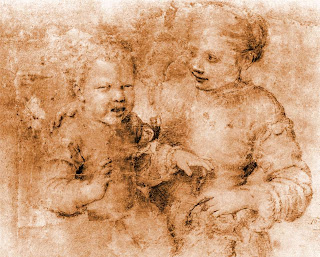1554
I definitely admire Anguisolla for her boldness and ability to break the traditional mold of male Italian artists. However, I also think it's a pity that her contemporary critics, approving as they were, could not separate her sex from her art. The prominent Dutch critic Vasari wrote: Anguissola has shown greater application and better grace than any other woman of our age in her endeavors at drawing; she has thus succeeded not only in drawing, coloring and painting from nature, and copying excellently from others, but by herself has created rare and very beautiful paintings.
"Lucia, Minerva and Europa Anguissola Playing Chess" by Sofonisba Anguissola (1532-1625)
Another quotation from Vasari is translated to: "If women know so well how to make living men, what marvel is it that those who wish are also so well able to make them in painting?" Vasari essentially relates Anguisolla's ability in painting portraiture to her capability of childbirth. As shown in the previous painting, Anguissola has the skill of incorporating a certain liveliness to her subjects that make them seem real. While it's an improvement that male critics paid any attention to Anguisolla at all, it is still unfortunate that they so clearly analyzed her work on a completely different level than they would with another male artist. Nevertheless, her technique and skills are quite extraordinary and it's fortunate that she was recognized at all. She lived out a very blessed life well into her 90s, supported by a generous pension, a happy marriage, and a good deal of fame.
Self-portrait, 1556
Sources:
1.) Fredrika Jacobs. "Sofonisba Anguissola, a Renaissance Woman by Sylvia Ferino-Pagden ; Maria Kusche." Woman's Art Journal, Vol. 17, No. 1 (Spring - Summer, 1996), pp. 45-47
2.) Jacobs, Frederika H. "Woman's Capacity to Create: The Unusual Case of Sofonisba Anguissola." Renaissance Quarterly, Vol. 47, No. 1 (Spring, 1994), pp. 74-101



No comments:
Post a Comment